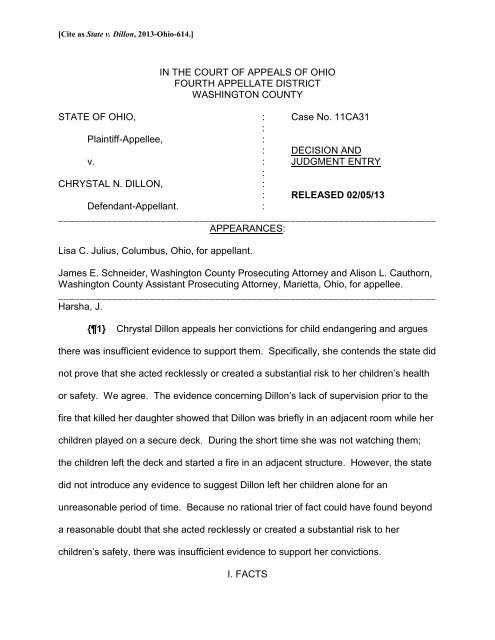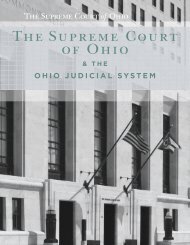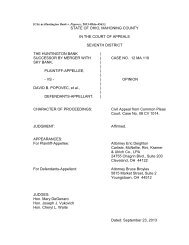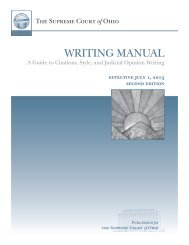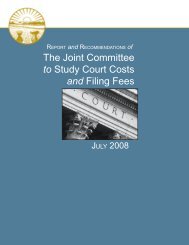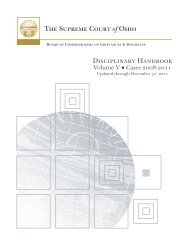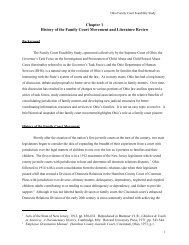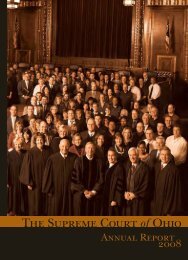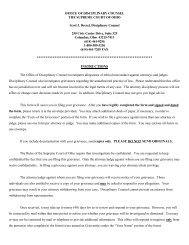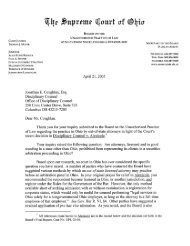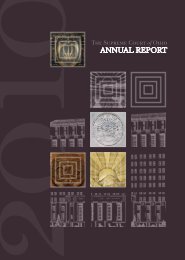State v. Dillon - Supreme Court - State of Ohio
State v. Dillon - Supreme Court - State of Ohio
State v. Dillon - Supreme Court - State of Ohio
Create successful ePaper yourself
Turn your PDF publications into a flip-book with our unique Google optimized e-Paper software.
[Cite as <strong>State</strong> v. <strong>Dillon</strong>, 2013-<strong>Ohio</strong>-614.]<br />
IN THE COURT OF APPEALS OF OHIO<br />
FOURTH APPELLATE DISTRICT<br />
WASHINGTON COUNTY<br />
STATE OF OHIO, : Case No. 11CA31<br />
:<br />
Plaintiff-Appellee, :<br />
: DECISION AND<br />
v. : JUDGMENT ENTRY<br />
:<br />
CHRYSTAL N. DILLON, :<br />
: RELEASED 02/05/13<br />
Defendant-Appellant. :<br />
______________________________________________________________________<br />
APPEARANCES:<br />
Lisa C. Julius, Columbus, <strong>Ohio</strong>, for appellant.<br />
James E. Schneider, Washington County Prosecuting Attorney and Alison L. Cauthorn,<br />
Washington County Assistant Prosecuting Attorney, Marietta, <strong>Ohio</strong>, for appellee.<br />
______________________________________________________________________<br />
Harsha, J.<br />
{1} Chrystal <strong>Dillon</strong> appeals her convictions for child endangering and argues<br />
there was insufficient evidence to support them. Specifically, she contends the state did<br />
not prove that she acted recklessly or created a substantial risk to her children’s health<br />
or safety. We agree. The evidence concerning <strong>Dillon</strong>’s lack <strong>of</strong> supervision prior to the<br />
fire that killed her daughter showed that <strong>Dillon</strong> was briefly in an adjacent room while her<br />
children played on a secure deck. During the short time she was not watching them;<br />
the children left the deck and started a fire in an adjacent structure. However, the state<br />
did not introduce any evidence to suggest <strong>Dillon</strong> left her children alone for an<br />
unreasonable period <strong>of</strong> time. Because no rational trier <strong>of</strong> fact could have found beyond<br />
a reasonable doubt that she acted recklessly or created a substantial risk to her<br />
children’s safety, there was insufficient evidence to support her convictions.<br />
I. FACTS
Washington App. 11CA31 2<br />
{2} This case arises from a fire that tragically killed two-year-old Bianca<br />
Jackson. Four-year-old Josh McCullors, Bianca’s brother, was also in the building when<br />
the fire began, but escaped unharmed. As a result <strong>of</strong> this fire, the state charged<br />
Chrystal <strong>Dillon</strong>, the children’s mother, with one count <strong>of</strong> involuntary manslaughter and<br />
two counts <strong>of</strong> child endangering. She pleaded not guilty and the case proceeded to<br />
trial.<br />
{3} At trial, the state contended that before the fire the two children were left<br />
unsupervised to play on the deck <strong>of</strong> the family home. The state alleged that after <strong>Dillon</strong><br />
went into a bedroom and left the children unattended, Josh and Bianca and entered an<br />
abandoned structure next to their home and Josh started the fire. The jury convicted<br />
<strong>Dillon</strong> <strong>of</strong> two counts <strong>of</strong> child endangering, in violation <strong>of</strong> R.C. 2919.22(A)&(E)(2)(c) for<br />
Bianca and R.C. 2919.22(A)&(E)(2)(a) for Josh. The jury was hung on the involuntary<br />
manslaughter charge. The court sentenced <strong>Dillon</strong> to a six month term on each count to<br />
be served concurrently. <strong>Dillon</strong> now appeals these convictions.<br />
II. ASSIGNMENTS OF ERROR<br />
{4} Dillion presents two assignments <strong>of</strong> error for our review:<br />
{5} 1. “THE JURY’S VERDICT FINDING DEFENDANT-APPELLANT GUILTY<br />
OF TWO COUNTS OF ENDANGERING CHILDREN, A FELONY OF THE<br />
THIRD DEGREE AND MISDEMEANOR OF THE FIRST DEGREE, IS<br />
NOT SUPPORTED BY SUFFICIENT EVIDENCE.”<br />
{6} 2. “THE JURY’S VERDICT FINDING THE DEFENDANT-APPELLANT<br />
GUILTY OF TWO COUNTS OF ENDANGERING CHILDREN IS<br />
AGAINST THE MANIFEST WEIGHT OF THE EVIDENCE.”<br />
III. SUFFICIENCY OF THE EVIDENCE<br />
{7} Initially, Dillion argues that there is insufficient evidence to support her<br />
convictions for child endangering. She contends that the state did not prove she had
Washington App. 11CA31 3<br />
the culpable mental state, i.e. recklessness, required to convict her <strong>of</strong> child<br />
endangering. Likewise, she also claims that the evidence presented at trial did not<br />
prove beyond a reasonable doubt that her temporary lack <strong>of</strong> supervision created a<br />
substantial risk <strong>of</strong> harm.<br />
A. Standard <strong>of</strong> Review<br />
{8} “An appellate court’s function when reviewing the sufficiency <strong>of</strong> the<br />
evidence to support a criminal conviction is to examine the evidence admitted at trial to<br />
determine whether such evidence, if believed, would convince the average mind <strong>of</strong> the<br />
defendant’s guilt beyond a reasonable doubt. The relevant inquiry is whether, after<br />
viewing the evidence in a light most favorable to the prosecution, any rational trier <strong>of</strong><br />
fact could have found the essential elements <strong>of</strong> the crime proven beyond a reasonable<br />
doubt.” <strong>State</strong> v. Jenks, 61 <strong>Ohio</strong> St.3d 259, 574 N.E.2d 492 (1991), paragraph two <strong>of</strong> the<br />
syllabus (superseded by statute and constitutional amendment on other grounds).<br />
{9} This test raises a question <strong>of</strong> law and does not allow the appellate court to<br />
weigh the evidence. <strong>State</strong> v. Osman, 4th Dist. No. 09CA36, 2011-<strong>Ohio</strong>-4626, 39. A<br />
sufficiency <strong>of</strong> the evidence challenge tests whether the state’s case is legally adequate<br />
to go to a jury in that it contains prima facie evidence <strong>of</strong> all <strong>of</strong> the elements <strong>of</strong> the<br />
charged <strong>of</strong>fense. See Portsmouth v. Wrage, 4th Dist. No. 08CA3237, 2009-<strong>Ohio</strong>-3390,<br />
36.<br />
{10} A conviction that is based on legally insufficient evidence constitutes a<br />
denial <strong>of</strong> due process. <strong>State</strong> v. Thompkins, 78 <strong>Ohio</strong> St.3d 380, 386-387, 678 N.E.2d<br />
541 (1997). And the Double Jeopardy Clause precludes retrial once the reviewing court
Washington App. 11CA31 4<br />
has found the evidence legally insufficient to support a conviction. Tibbs v. Florida, 457<br />
U.S. 31, 40–41, 102 S.Ct. 2211, 72 L.Ed.2d 652 (1982). See also Thompkins at 387. 1<br />
B. Law and Analysis<br />
{11} <strong>Dillon</strong> was convicted <strong>of</strong> two counts <strong>of</strong> child endangering in violation <strong>of</strong> R.C.<br />
2919.22(A), which states: “No person, who is the parent * * * <strong>of</strong> a child under eighteen<br />
years <strong>of</strong> age * * * shall create a substantial risk to the health or safety <strong>of</strong> the child, by<br />
violating a duty <strong>of</strong> care, protection, or support.” “It is not necessary to show an actual<br />
instance or pattern <strong>of</strong> physical abuse on the part <strong>of</strong> the accused in order to justify a<br />
conviction under R.C. 2919.22(A).” <strong>State</strong> v. Kamel, 12 <strong>Ohio</strong> St.3d 306, 308, 466 N.E.2d<br />
860 (1984). “[A]n inexcusable failure to act in discharge <strong>of</strong> one's duty to protect a child<br />
where such failure to act results in a substantial risk to the child’s health or safety is an<br />
<strong>of</strong>fense under R.C. 2919.22(A).” Id. at 309.<br />
{12} Although not expressed in the statute, “the existence <strong>of</strong> the culpable<br />
mental state <strong>of</strong> recklessness is an essential element <strong>of</strong> the crime <strong>of</strong> endangering<br />
children under R.C. 2919.22(A).” <strong>State</strong> v. McGee, 79 <strong>Ohio</strong> St.3d 193, 195, 680 N.E.2d<br />
975 (1997). Thus, a successful R.C. 2919.22(A) conviction requires the state to prove<br />
that: (1) a person having custody or control over a child under eighteen years <strong>of</strong> age (2)<br />
recklessly (3) created a substantial risk to the health or safety <strong>of</strong> the child (4) by<br />
violating a duty <strong>of</strong> care, protection, or support. See <strong>State</strong> v. Swain, 4th Dist. No.<br />
01CA2591, 2002 WL 146204, *7 (Jan. 23, 2002).<br />
1 There is a notable distinction between a reversal based upon insufficient evidence and one resting upon<br />
the weight <strong>of</strong> the evidence. <strong>State</strong> v. Thompkins, 78 <strong>Ohio</strong> St.3d 380, 387, 678 N.E.2d 541 (1997). In<br />
contrast, a finding that the jury’s verdict was against the weight <strong>of</strong> the evidence does not preclude a retrial<br />
under the Double Jeopardy Clause. Tibbs v. Florida, 457 U.S. 31, 43, 102 S.Ct. 2211, 72 L.Ed.2d 652<br />
(1982). See also Thompkins at 387.
Washington App. 11CA31 5<br />
{13} <strong>Dillon</strong> does not dispute that she had custody or control over her children,<br />
who were under 18 years <strong>of</strong> age at the time <strong>of</strong> fire, or that she had a duty to protect<br />
them. She does, however, challenge that she acted recklessly and that her conduct<br />
created a substantial risk to the safety <strong>of</strong> her children. Thus, we focus on these last two<br />
elements.<br />
1. Recklessness<br />
{14} “A person acts recklessly when, with heedless indifference to the<br />
consequences, he perversely disregards a known risk that his conduct is likely to cause<br />
a certain result or is likely to be <strong>of</strong> a certain nature. A person is reckless with respect to<br />
circumstances when, with heedless indifference to the consequences, he perversely<br />
disregards a known risk that such circumstances are likely to exist.” R.C. 2901.22(C).<br />
{15} The state’s evidence showed that <strong>Dillon</strong> did not have electricity and used<br />
candles to light her home. Leonard Wilfong, <strong>Dillon</strong>’s neighbor, testified that he saw<br />
black smoke coming from the adjacent structure and ran over to <strong>Dillon</strong>’s home to let<br />
them know. He stated that <strong>Dillon</strong> and her boyfriend came out the front door and then<br />
ran toward the fire. At this time, he did not see the children. <strong>Dillon</strong> tried to enter the<br />
structure, but Wilfong testified that the flames were too large and he pulled her back.<br />
He stated that <strong>Dillon</strong> and her boyfriend “always had fireworks in [the structure]” and he<br />
could hear them “popping <strong>of</strong>f” while the house was burning. He also testified that in the<br />
past he had seen <strong>Dillon</strong>’s children playing unsupervised in the street outside the home.<br />
Wilfong further testified that the day before the fire, he heard <strong>Dillon</strong>’s boyfriend yell<br />
“Chrystal * * * [Josh] started a fire on the porch again.”
Washington App. 11CA31 6<br />
{16} Cory McCullors, Josh’s father, testified that a short time after the fire he<br />
pulled out his lighter and asked Josh “what’s this?” Josh was upset. He picked it up<br />
and pushed the button and then responded “Daddy, that’s what started the fire. Sissy<br />
got scared and ran in the back room.” However Josh did not ignite the lighter and<br />
McCullors stated “all he could do was push the button.” He also stated that he had<br />
never seen his son use a lighter before.<br />
{17} Karen Seagraves, a Children’s Services caseworker, testified that she had<br />
been working with <strong>Dillon</strong> and her children since January 2009. Her contact with the<br />
family began while she was visiting a home in the area and saw Bianca unattended in<br />
the middle <strong>of</strong> the street. During her monthly visits and in the family’s case plan, she<br />
addressed the issue <strong>of</strong> supervision with <strong>Dillon</strong>. She also addressed the issue <strong>of</strong><br />
fireworks and explained that the children should not have access to any fireworks, even<br />
sparklers.<br />
{18} On cross-examination, Seagraves testified that she asked <strong>Dillon</strong> to put up<br />
a gate on the deck to keep the children contained. She explained that <strong>Dillon</strong> complied<br />
and put up a gate and also some materials around the bottom <strong>of</strong> the deck so the<br />
children could not crawl through. A few weeks before the fire, Seagraves made<br />
another home visit and noted that there were no “serious safety hazards” present in the<br />
home that would cause “imminent risk <strong>of</strong> harm” to the children. In spite <strong>of</strong> the lack <strong>of</strong><br />
electricity and the use <strong>of</strong> candles, she indicated she did not observe any lighters in the<br />
home, although both <strong>Dillon</strong> and her boyfriend smoked.<br />
{19} Michael Stellfox, an investigator for the <strong>Ohio</strong> <strong>State</strong> Fire Marshal’s Office,<br />
testified as an expert witness. He explained that <strong>Dillon</strong>’s home was connected to the
Washington App. 11CA31 7<br />
vacant structure by a common deck. After examining the scene, he concluded he could<br />
not determine the exact point <strong>of</strong> origin, although he believed the fire started on the<br />
ground floor. He also testified someone “most likely” introduced an open flame<br />
somewhere in the structure and, because the vacant structure did not have electricity,<br />
he was able to rule it out as a cause. During his investigation, he found “punks,” that<br />
are used to light fireworks scattered everywhere throughout the structure. He explained<br />
that an open flame must be used to light the punk stick initially and that the punk sticks<br />
smolder, but do not flame. However, the tip <strong>of</strong> the punk stick remains hot and if it<br />
touches something flammable that item would ignite.<br />
{20} During cross-examination, the defense played an interview between<br />
Stellfox and <strong>Dillon</strong> recorded on the night <strong>of</strong> the fire. During the interview <strong>Dillon</strong> stated<br />
that just prior to the fire she was in kitchen cleaning up with her boyfriend and the<br />
children were outside on the deck riding bikes. Then “a couple <strong>of</strong> seconds later” Josh<br />
came running inside and said “Fire, Daddy, fire, Daddy.” <strong>Dillon</strong> stated they ran outside<br />
and saw the neighbor screaming the house is on fire. <strong>Dillon</strong> asked Josh where his<br />
sister was and he said she was in the structure. She tried to enter the burning structure,<br />
but her boyfriend stopped her. She then called the police department.<br />
{21} During this interview, <strong>Dillon</strong> also discussed a fire on the deck at their home<br />
two days before. She explained she had taken an old desk out onto the deck. She said<br />
that her boyfriend told her that Josh caught the desk on fire, but she did not see how<br />
that could have happened.<br />
{22} Ernest Clevenger, Chief <strong>of</strong> Police <strong>of</strong> the City <strong>of</strong> Belpre, testified that in the<br />
past he had visited <strong>Dillon</strong>’s home due to complaints about the use <strong>of</strong> fireworks. And
Washington App. 11CA31 8<br />
during one visit he confiscated a large quantity <strong>of</strong> fireworks from the home, a portion <strong>of</strong><br />
which were returned after examination. He later saw them in the basement <strong>of</strong> the<br />
vacant structure next to <strong>Dillon</strong>’s home where the fire began. However, this was over a<br />
year prior to the day in question.<br />
{23} Timothy Wilhelm, a fire investigator, testified as an expert witness for the<br />
defense. He testified that he believed the fire started on the ground floor and the cause<br />
<strong>of</strong> the fire was “undetermined.” He explained that this meant “a number <strong>of</strong> different”<br />
things could have caused the fire. He also testified that because the drywall had been<br />
removed from the vacant structure, he believed the fire would have accelerated faster.<br />
{24} Considering this evidence in a light most favorable to the state, we<br />
conclude a reasonable juror could find that there was a known risk that Josh could start<br />
a fire. This conclusion is based in large part on Wilfong’s testimony that he overheard<br />
<strong>Dillon</strong>’s boyfriend say the day before that Josh had started “another” fire on the deck<br />
and her own admission about the desk fire. However, recklessness also requires that<br />
the actor “perversely disregards a known risk….” We cannot say that a parent who<br />
leaves her children unattended on a secured deck while she briefly attends to<br />
housekeeping matters perversely disregards the risk that the children will leave the deck<br />
and start a fire in an adjacent structure containing fireworks. Such a parent might easily<br />
be found negligent but that is not the mens rea for child endangering. We might also<br />
find that her culpability could escalate to recklessness in the event she left the children<br />
unattended for an extended period <strong>of</strong> time or while she left the premises for an<br />
unreasonable period. But neither <strong>of</strong> those circumstances is reflected by the evidence<br />
here. In fact, the only evidence concerning the amount <strong>of</strong> time the children were
Washington App. 11CA31 9<br />
unsupervised on the porch came from <strong>Dillon</strong> who testified the children were alone for<br />
“…a couple <strong>of</strong> seconds….” Although this testimony is subject to scrutiny as being both<br />
self-serving and somewhat improbable, there is nothing in the record to indicate how<br />
long the children were on the porch before the fire started.<br />
{25} Likewise, we cannot conclude that leaving the children briefly unattended<br />
on a gated deck was likely to result in one <strong>of</strong> them igniting the fireworks in an adjacent<br />
structure, i.e. it was likely to cause a certain result. There was no testimony about how<br />
Josh started the previous fire or that any incendiary device was available to him while<br />
he played on the deck. Although there was testimony that the vacant structure had<br />
previously contained fireworks and punk sticks were found at the scene, there was no<br />
evidence presented that the children had access to an incendiary device on the day in<br />
question. Therefore, we cannot say that <strong>Dillon</strong>’s conduct was likely to cause a certain<br />
result, i.e. harm to her children. Accordingly, there was insufficient evidence to prove<br />
she acted recklessly.<br />
2. Substantial Risk<br />
{26} R.C. 2901.01(A)(8) defines “substantial risk” as “a strong possibility, as<br />
contrasted with a remote or significant possibility, that a certain result may occur or that<br />
certain circumstances may exist.”<br />
{27} Here, much <strong>of</strong> the state’s evidence focused upon what caused the fire.<br />
There was only minimal testimony concerning Dillion’s lack <strong>of</strong> supervision. We reiterate<br />
that our review <strong>of</strong> the record in this case reveals that the only evidence presented about<br />
<strong>Dillon</strong>’s lack <strong>of</strong> supervision <strong>of</strong> the children prior to the fire, was her statements to Stellfox<br />
that she was in the kitchen cleaning up while the children were riding their bikes on the
Washington App. 11CA31 10<br />
deck and that “a couple <strong>of</strong> seconds later” there was a fire. The diagram <strong>of</strong> <strong>Dillon</strong>’s<br />
home entered into evidence by the state shows that the kitchen is adjacent to the deck.<br />
Although the state claims in its brief that “[t]here was no defense evidence introduced to<br />
establish where the Appellant and her boyfriend were in relation to the children, how<br />
long it had been since they had seen them, how <strong>of</strong>ten they were checking on them,<br />
whether they had secured the vacant house, whether they had secured lighters and<br />
matches, or what other steps they were taking prior to the fire to supervise the children<br />
and protect them from harm,” this was not the defense’s burden. Rather, the state has<br />
the burden <strong>of</strong> proving every element <strong>of</strong> the charged <strong>of</strong>fense beyond a reasonable doubt.<br />
<strong>State</strong> v. Adams, 103 <strong>Ohio</strong> St.3d 508, 2004-<strong>Ohio</strong>-5845, 817 N.E.2d 29, 97.<br />
{28} We find that merely leaving her children unattended on a secured deck<br />
while <strong>Dillon</strong> was in the adjacent kitchen, without further evidence concerning a lack <strong>of</strong><br />
supervision, did not create a substantial risk to the children’s health or safety. The<br />
evidence showed that <strong>Dillon</strong> was in the kitchen cleaning up while her children were<br />
riding their bikes on a secured deck. <strong>Dillon</strong> told Stellfox during the interview that one <strong>of</strong><br />
the french doors leading from the kitchen to the deck was open. She also stated that<br />
after only a “couple <strong>of</strong> seconds” Josh ran inside yelling fire. Without further evidence<br />
that the children had access to some incendiary device or how long they were<br />
unattended on the deck, <strong>Dillon</strong>’s lack <strong>of</strong> supervision did not create a strong possibility<br />
that harm would occur to the children in spite <strong>of</strong> the presence <strong>of</strong> fireworks at an adjacent<br />
structure. Thus, even considering the evidence most favorable to the state, there is<br />
insufficient evidence to prove that <strong>Dillon</strong> created a substantial risk to the children’s<br />
health or safety.
Washington App. 11CA31 11<br />
{29} The state cites <strong>State</strong> v. Torr, 10th Dist. No. 00AP-1418, 2002 WL 47040,<br />
(Jan. 15, 2002), to support its argument that it presented sufficient evidence to support<br />
the convictions. Torr is factually distinguishable from this case. There, a five-year-old<br />
child also died in a house fire. However, the child in that case had previously set as<br />
many as nine fires. Id. at *3. The most serious <strong>of</strong> these incidents involved a chair fire<br />
that caused significant damage to an upstairs bedroom. Id. The child admitted that he<br />
started the fire using a cigarette lighter. Id. Furthermore, after that incident the<br />
defendant refused to take her son to an education program recommended by the fire<br />
department to address her son’s fixation with fire. Id. at *4. Several other witnesses<br />
testified that the defendant was aware <strong>of</strong> her son’s involvement with lighters and fires<br />
and some indicated the problem was serious and continuing. Id. Thus, unlike <strong>Dillon</strong>, the<br />
mother in Torr had ample notice <strong>of</strong> her son’s curiosity with fire and usage <strong>of</strong> lighters and<br />
continued to smoke in the house. Furthermore, when the fire occurred, the mother in<br />
Torr had left her son with a 12-year-old aunt who the mother also let smoke her in<br />
house. Thus, Torr is clearly distinguishable.<br />
IV. CONCLUSION<br />
{30} The state failed to present sufficient evidence to show <strong>Dillon</strong> recklessly<br />
created a substantial risk to her children’s safety by violating a duty <strong>of</strong> care. Even after<br />
viewing the evidence in a light most favorable to the prosecution, we conclude no<br />
rational trier <strong>of</strong> fact could have found beyond a reasonable doubt that <strong>Dillon</strong> committed<br />
all the necessary elements <strong>of</strong> the charged <strong>of</strong>fense. Accordingly, we sustain her first<br />
assignment <strong>of</strong> error. <strong>Dillon</strong>’s remaining assignment <strong>of</strong> error is rendered moot. See<br />
App.R. 12(A)(1)(c).
Washington App. 11CA31 12<br />
{31} We reverse the judgment <strong>of</strong> the trial court and remand with instructions to<br />
discharge the appellant.<br />
JUDGMENT REVERSED<br />
AND CAUSE REMANDED.
Washington App. 11CA31 13<br />
JUDGMENT ENTRY<br />
It is ordered that the JUDGMENT IS REVERSED and that the CAUSE IS<br />
REMANDED. Appellee shall pay the costs.<br />
The <strong>Court</strong> finds there were reasonable grounds for this appeal.<br />
It is ordered that a special mandate issue out <strong>of</strong> this <strong>Court</strong> directing the<br />
Washington County <strong>Court</strong> <strong>of</strong> Common Pleas to carry this judgment into execution.<br />
IF A STAY OF EXECUTION OF SENTENCE AND RELEASE UPON BAIL HAS<br />
BEEN PREVIOUSLY GRANTED BY THE TRIAL COURT OR THIS COURT, it is<br />
temporarily continued for a period not to exceed sixty days upon the bail previously<br />
posted. The purpose <strong>of</strong> a continued stay is to allow Appellant to file with the <strong>Supreme</strong><br />
<strong>Court</strong> <strong>of</strong> <strong>Ohio</strong> an application for a stay during the pendency <strong>of</strong> proceedings in that court.<br />
If a stay is continued by this entry, it will terminate at the earlier <strong>of</strong> the expiration <strong>of</strong> the<br />
sixty day period, or the failure <strong>of</strong> the Appellant to file a notice <strong>of</strong> appeal with the<br />
<strong>Supreme</strong> <strong>Court</strong> <strong>of</strong> <strong>Ohio</strong> in the forty-five day appeal period pursuant to Rule II, Sec. 2 <strong>of</strong><br />
the Rules <strong>of</strong> Practice <strong>of</strong> the <strong>Supreme</strong> <strong>Court</strong> <strong>of</strong> <strong>Ohio</strong>. Additionally, if the <strong>Supreme</strong> <strong>Court</strong><br />
<strong>of</strong> <strong>Ohio</strong> dismisses the appeal prior to expiration <strong>of</strong> sixty days, the stay will terminate as<br />
<strong>of</strong> the date <strong>of</strong> such dismissal.<br />
A certified copy <strong>of</strong> this entry shall constitute the mandate pursuant to Rule 27 <strong>of</strong><br />
the Rules <strong>of</strong> Appellate Procedure. Exceptions.<br />
Kline, J.: Concurs in Judgment and Opinion.<br />
Abele, J.: Dissents.<br />
For the <strong>Court</strong><br />
BY: ________________________<br />
William H. Harsha, Judge<br />
NOTICE TO COUNSEL<br />
Pursuant to Local Rule No. 14, this document constitutes a final judgment<br />
entry and the time period for further appeal commences from the date <strong>of</strong> filing<br />
with the clerk.


